Optimising carbon fixation part 2 LECTURE 4
1/46
There's no tags or description
Looks like no tags are added yet.
Name | Mastery | Learn | Test | Matching | Spaced |
|---|
No study sessions yet.
47 Terms
CAM
Crassulacean Acid Metabolism
CAM vs C4
C4→ Spatially separated CO2 assimilation and fixation
CAM→ temporal assmilation and fixation
How many plants use CAM?
5% of all plant species
more than 35 plant families
→ much more widespread than C4
Where are CAM plants found?
Semi -arid
BUT ALSO
Can be aquatic
Examples of CAM plants
Succulents
Pineapple
agave
vanilla
Cacti
Orchids
some ferns
strangling figs
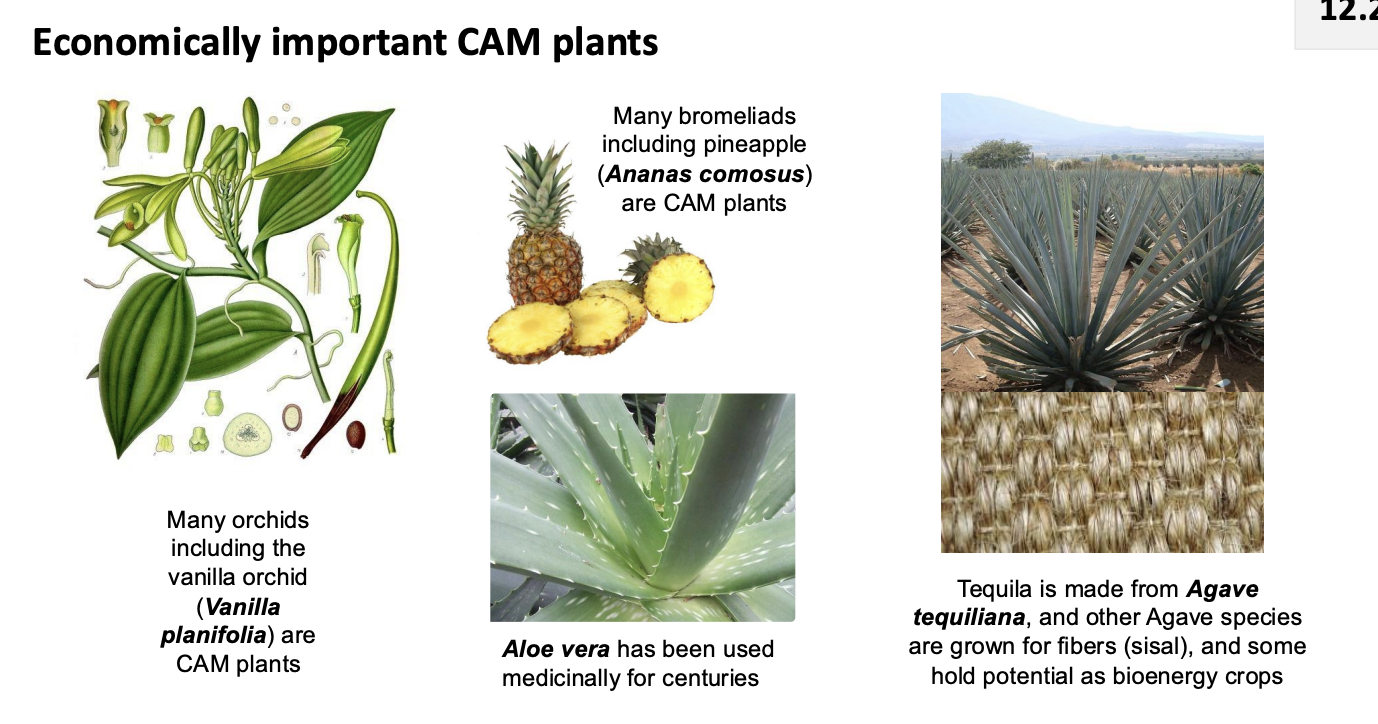
CAM plants native to the UK
Sedum anglicum
Sedum telephium
Sedum acre
SEDUM family

How does CAM work
NIGHT: Fixation: sugars→ C3 acids→ PEPC with HCO3- to make C4 acids (malic acid)
Done overnight (instead of in separate cell)
so need a lot of sugars at night to fuel this!
Malic acid accumulates overnight→ cell vacuole
DAY: decarboxylation
C4→C3 acids and CO2 out (for RUBisco) → back into sugars
SO then can be used by Rubisco in the light
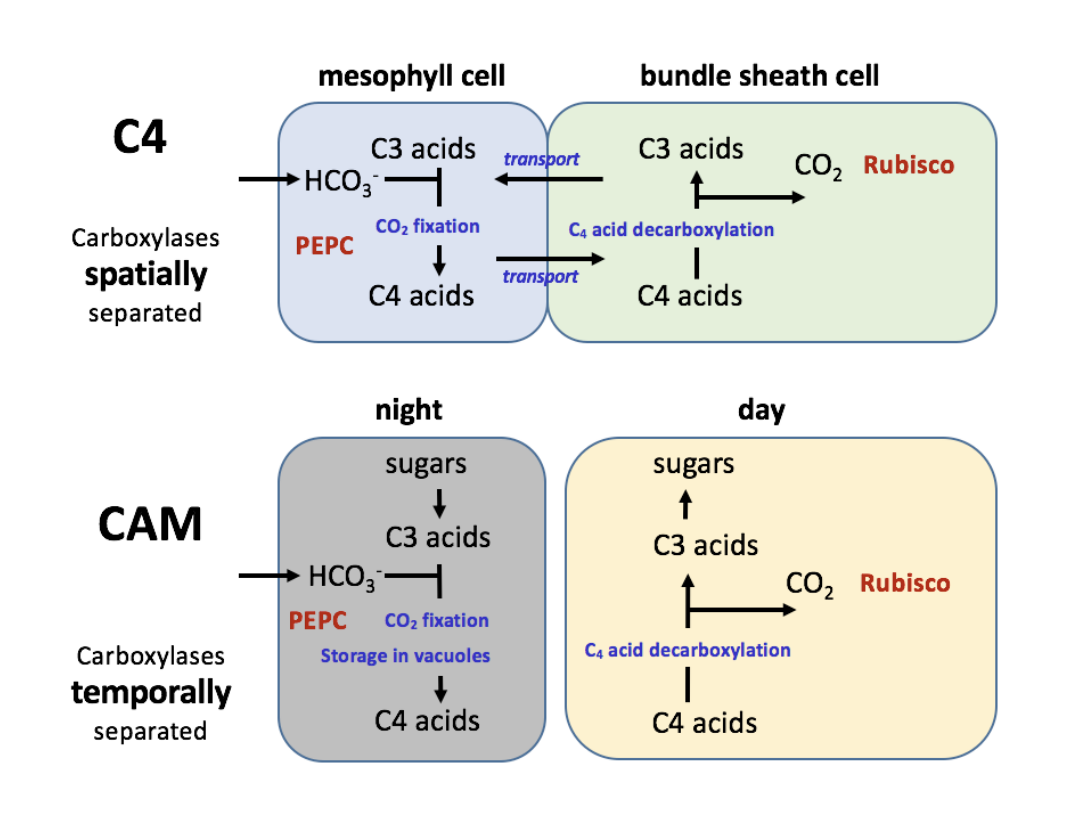
Temporal separation→ Different stages Pt1
Phase 1: NIGHT→ Stomata open
Vapour pressure high
transpiration low
→ PEPC activity:
Malic acid increases→ into vacuoles
Glucan increases as it is converted into Malic
CO2 fixation increased due to PEPC activity
The stomata are open for this
Phase 2: EARLY MORNING→ Stomata open
Malic acid→ stop increasing (starts to decrease)
CO2 → Spike and then decrease (as stomata then shut!)
Glucan→ slight increase?
WHY:
Transition of PEPC → Rubsico acitivity
→ burst of CO2 uptake until stomata close
(one of two transient daytime phases where additional CO2 fixation may occur)

Temporal separation→ Different stages Pt2
Phase 3: Morning and afternoon
Malic acid→ decreases
CO2 assim→ low then increase
Glucan→ increases
WHY:
stomata close
→ Malic acid is Decarboxylated (decreases)
High concentrations of CO2 made (under closed doors) (low CO2)
→ used to suppress photorespiration
This replenishes large storage of carbs used at night (glucan increases)
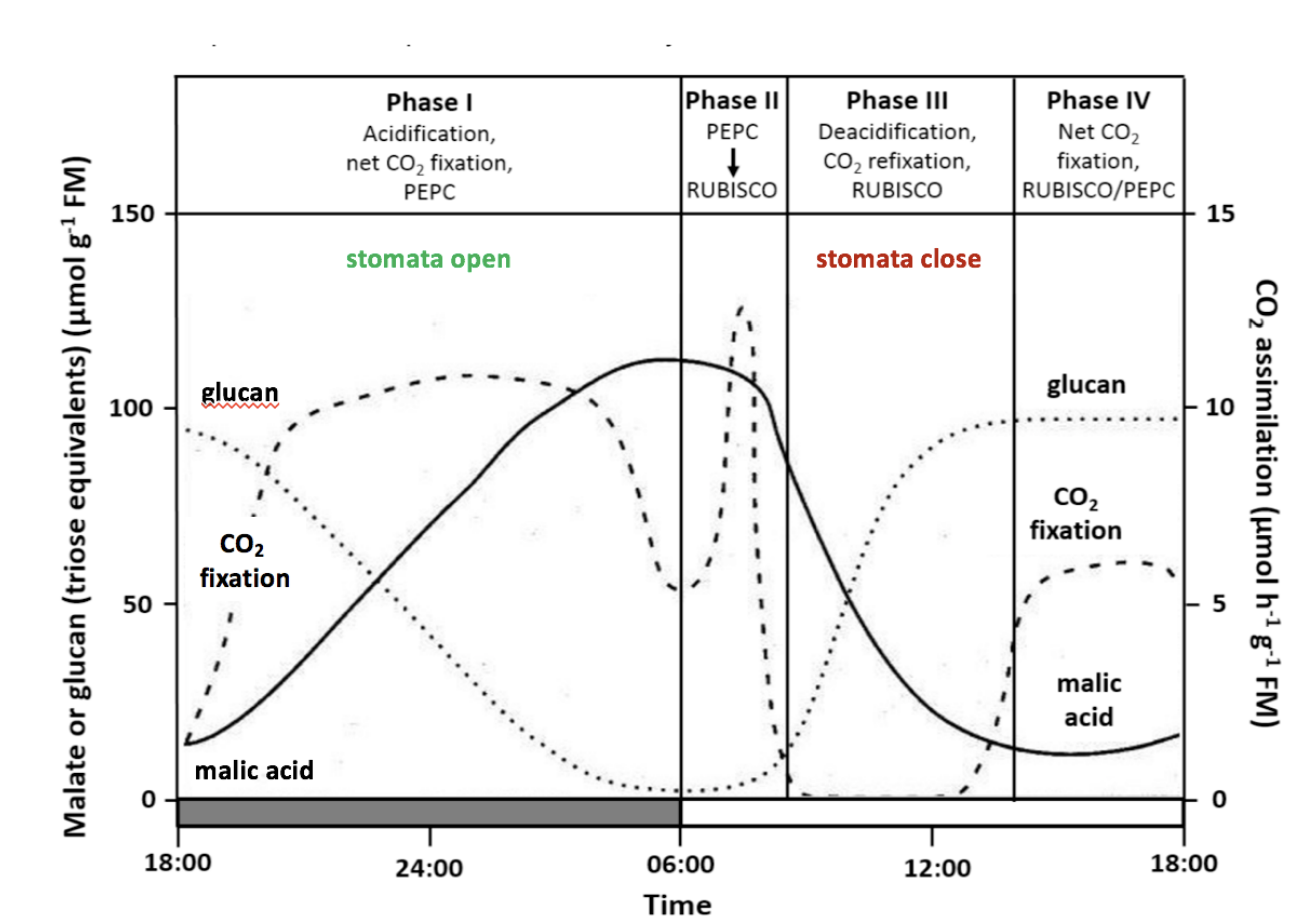
Temporal separation→ Different stages Pt3
PHASE 4: Evening
malic→ slight increase
CO2 assim→ slight increase then plataeu
Glucan→ plateau
WHY:
Stomata re-open→ if well supplied with water
Direct C3 photosynthesis:
takes in CO2
glucan gonna be made
Malic not really made
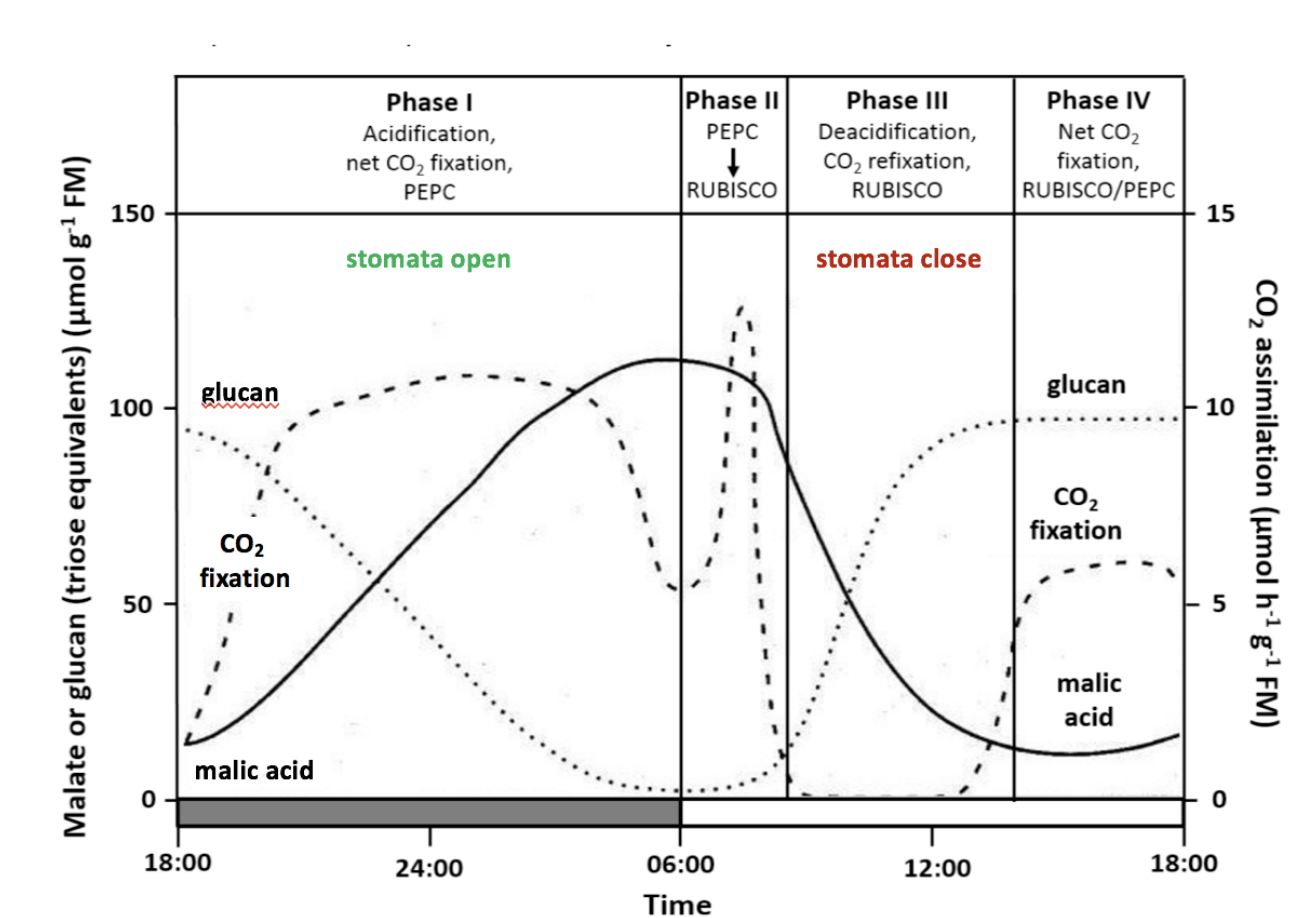
How to measure the CAM activity?
Take leaf samples at dusk and dawn
back titrate the sap extract to neutrality
Allows to calculate how much malic acid present
C3 vs CAM anatomy 1
C3:
smaller cells
high intercellular airspace
thin leaves
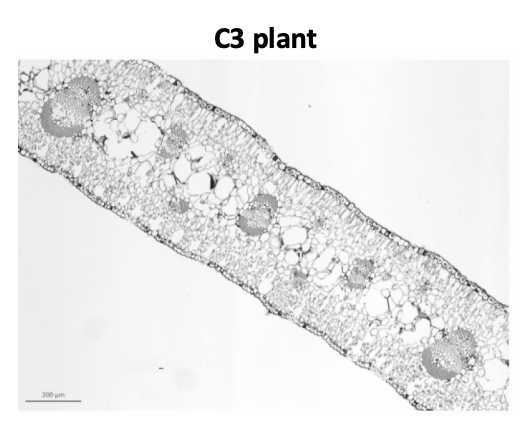
C3 vs CAM anatomy 2
CAM plants
Large cells
Large vacuoles
to store malate
Small intercellular airspace
tightly packed to reduce CO2 leakage
Thick leaves with thick waxy cuticle
Smaller and fewer stomata
prevent water loss
Adaptation to dry environments and to store a lot of malate (because it is not getting moved)
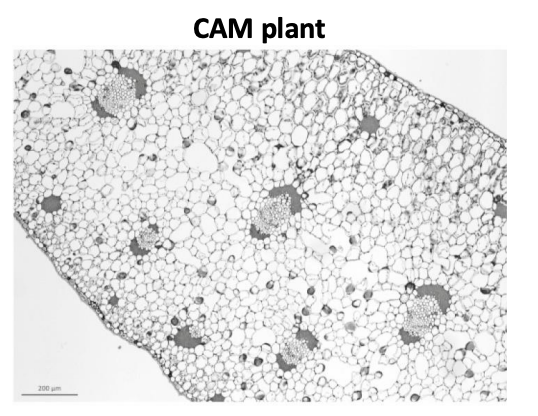
Stomata: Commelina communis vs CAM plants
smaller
behave differently
open at different times
Commelina communis:
Where: high humidity, sufficient water
Adaptations: large stomata, high stomatal density
CAM
Where: semi arid, water limitation
Adaptations: small stomata. low stomatal density

Stomata are regulated differently
C3 and C4 stomata open when:
daylight→ blue light
sufficient water
low internal CO2
Close when
high CO2→ low stomatal conductance
lack of light
low water→ ABA
CAM→ opposite
How open at night?
At night PEPC activity sequesters CO2 into C4 acids
Internal CO2 concentrations are LOW (coz its being converted constantly)
Low CO2→ no closing signal for stomata at night
→ Stay open
How closed in the day?
In the day: blue light could trigger opening BUT
PEPC→ Rubisco: So CO2 concentrations increase dramatically
due to carboxylation
The CO2 increase outweighs the light increase
→ Stomata close
Therefore: the principles are the same but Stomata close due to the internal CO2 concentrations
But to achieve the temporal separation
need to regulate when PEPC enzyme is available
Cant just put it in a different cell like in C4 plants
How is this done?
At night: de novo transcription of PEPC kinase
PEPC is activated by phosphorylation
The phosphoylated form is active because Malate does not inhibit it
In day: Phosphatase dephosphoyrlates it
Malic acid builds up
Dephosphylated enzyme is inhibited by malic acid
So PEPC becomes deactivated during the day

How is PEPC kinase controlled?
Under circadian control
Facultative CAM plants
Can switch CAM on and off
In response to drought or high light
Facultative CAM e.gs
Ice Plant Mesembryanthemum crystallinum
Responds to salinity and drought
Clusia pratensis
Talinum triangulare
Clusia pratensis → use CAM when stressed
Water withheld
Switched to gas exchange at night→ CAM
Switch back to the day when water provided

Talinum triangulare→ CAM when stressed
Drought
Increase in night-time acid storage→ CAM

Ecological Advantages of CAM
Desert
Good at conserving water
Tropical forests
greater CAM biomass than in deserts
orchids, bromeliads
Aquatic
macrophytes
e.g fern ally, Isoetes, shoreweed
plants
hydrilla
→ Although lacks Kranz anatomy
Has convergently evolved in many families!
How advantageous in aquatic habitats?
CO2 diffuses 10000x more slowly
THEREFORE:
need a CO2 concentrating mechanism
also use sediment CO2 in carbon concentrating mechanisms
Other carbon concentrating mechanism found in
Diatoms
Dinoflagellates
Macroalgae
In the ocean→ IMPORTANT for primary producers to cope with infficiencies of Rubisco
Energetic requirements for CAM
Large amount of carbs needed at night
A lot of organelle storage for
carbs and organic acid
Transport between cell organelles
OVERALL: very high ATP and NADPH demand
Compared to C3
Even higher than C4
Much higher than C3
Due to this…
CAM plants can grow very slowly
Exception? Agave tequilana
Can be as productive as C3 and C4→HOW?
carbon-concentrating effect of stomatal closure in the day
sufficient to offset the energetic cost of running CAM
IF: nutrient availability are comparable
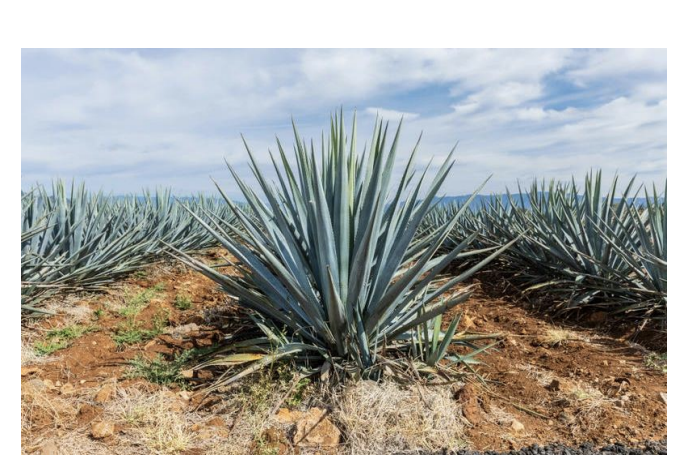
Why cant C4 and CAM operate at the same time?
Differences in metabolism
same enzymes needed by at
different times
different cells→ Rubisco and PEPC would compete for CO2 in the same cell mesophyll!
Differences in leaf anatomy
C4→ need Kranz anatomy
CAM→ need large mesophyll cells (not Kranz anatomy)
Exception→ Portulaca oleracea
C4 species but capable of expressing CAM photosynthesis
as a stress response
to drought

When water available
Uses C4
When water scarse
Uses CAM
How is this possible?
temporal up regulation of different isoforms of key enzymes
At night:
malate synthesised
in mesophyll cell
→ CAM
In day:
Malate released from mesophyll
transported to bundle sheath
decarboxylated: CO2→ Rubisco
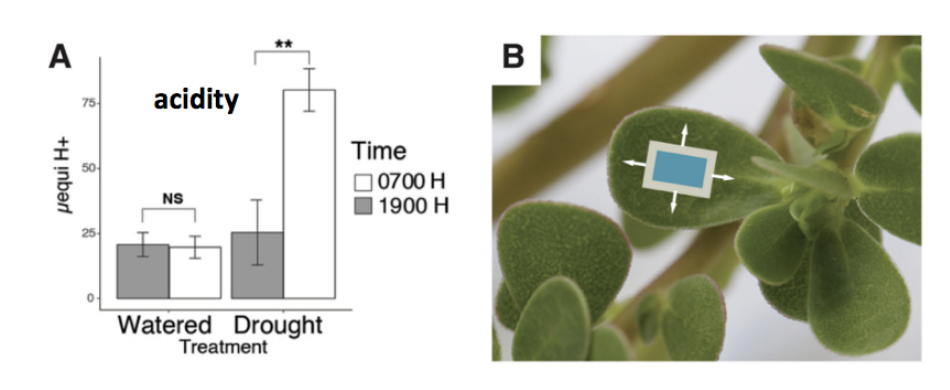
Why care about this?
Growing population
Need to feed→ need crop yields to increase
BUT ALSO
Climate change
less water
less land
higher temperatures
Must limit fertiliser use
What need to do to do this?
Increase photosynthesis
Increase water efficiency
Steps to improve photosynthesis
Pigments which use more of light spectrum
Engineered Rubisco with higher carboxylation efficiency
C4 pathways into C3 crops
Synthetic photo respiratory bypasses
Engineer improved water use efficiency
Pigments which use more of light spectrum
Could use pigments from other algae or bacteria
which uses light from non visible parts
intr-red and UV A
Engineered Rubisco with higher carboxylation efficiency
Many diverse forms of Rubisco across photosynthetic organism
O2 sensitivity, catalytic efficiency
Could harness this diversity
Could enhance carbon fixation rates
Use synthetic biology techniques
C4 pathways into C3 crops
C4 evolved over 60 times
So might be kinda easy to engineer C4 out of C3 crops
e.g trying to do this with rice
BUT: need to change
leaf anatomy
cell-type-specific expression of Calvin cycle enzymes
Synthetic photo respiratory bypasses
develop a shortcut from the long recycling procress of phosphoglycolate
enable to save energy
boost crop yields
Engineer improved water use efficiency
changes in stomata density or
stomata sensitivity to the environment
Issues with breeding stategies?
limited genetic diversity present in photosynthetic enzymes and pathways
Solution to this
Use
genetic engineering
Synthetic biology
But this can be difficult…
requires in-depth understanding of biological systems involved
adanved technologyies
synthetic biology tools
comprehensive genomic data of crop plants
